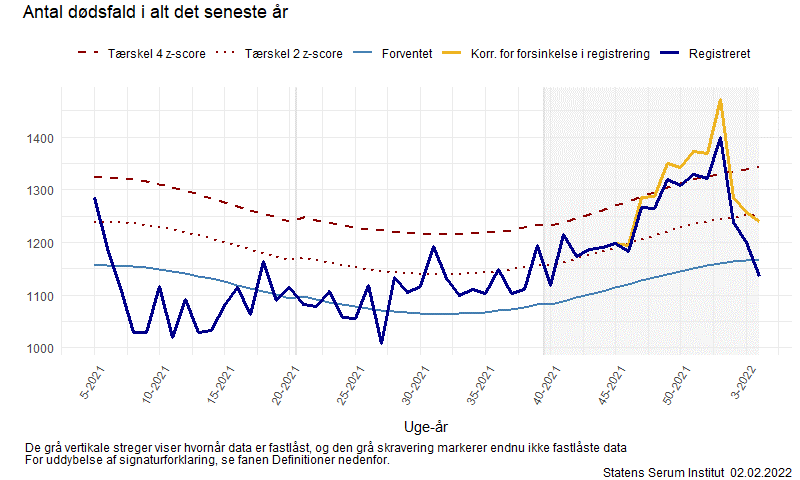EXPLAINED: Are deaths from Covid-19 in Denmark increasing?

Denmark's national infectious disease agency on Thursday published reports and information which addressed claims circulating on social media and elsewhere that the country is seeing increased deaths due to Covid-19.
Since broadly lifting Covid-19 restrictions at the beginning of February, the number of patients in Danish hospitals who have Covid-19 has increased markedly.
So has the registered number of deaths of people who died within 30 days after testing positive for Covid-19. On Thursday February 17th there were 44 deaths registered of people who had Covid-19 at the time of death or shortly before it.
That has resulted in debate – notably on social media – over Denmark's decision to lift restrictions, with some international critics arguing the data suggests the decision may not have been the correct one.
READ ALSO: Danish disease agency hits back over country’s Covid deaths data
In response, the Danish infectious disease agency State Serum Institute (SSI) has responded to these critics to try to set the record straight about the numbers.
In a number of tweets, the agency stressed that an increase in hospital patients who have Covid-19, and people who have or recently had the disease when they died, reflected the high level of transmission of the virus in the community – but not a higher level of sickness or death caused by Covid-19.
Many people who are in hospital who have tested positive for Covid-19 are not in hospital because of the virus but for an unconnected reason, SSI points out.
Similarly, because community transmission is high, a person who died for a reason unrelated to Covid-19 is more likely to have had Covid-19 within the last 30 days before they died, the criteria for inclusion in the national Covid-19 death statistic.
Are you interested in Danish Covid-19-deaths? Below, you can see information about deaths with Covid-19 (light🟡) and deaths by Covid-19 (dark🟠).
By = Covid-19 was the reason the person died.
With = The person had a positive PCR-test, but died of something other than Covid-19. https://t.co/3nySPEjkdv
— Statens Serum Inst. (@SSI_dk) February 14, 2022
SSI has also published English-language reports on its website in an effort to clarify the country’s Covid-19 data.
On Thursday, the agency posted a series of tweets which it said addressed “typical misinformation about (Danish) Covid-19 numbers”.
These include claims that criteria for admission to Danish ICUs with Covid-19 have changed and that an extremely high number are hospitalised because of Covid-19.
The tweets link to a report on the SSI website which attempts to rebut claims in more detail.
Typical misinformation about Danish C-19 numbers:
"Extremely many people are hospitalised because of C-19 in Denmark"
Answer: Incorrect. As of week 5, 2,391 C-19 positive persons had been hospitalised compared w. 296,630 PCR confirmed C-19 cases.
Read more https://t.co/sG7gaaFMHt pic.twitter.com/NbCxxg7qIT
— Statens Serum Inst. (@SSI_dk) February 15, 2022
On its website, SSI states that the mortality rate [the overall number of deaths, ed.] in Denmark is not rising.
“During the last months of 2021, Denmark saw a higher number of deaths than expected in persons older than 75 years of age, which is anticipated to be caused by the Delta variant,” the agency writes.
“However, as from week 1, 2022, mortality has decreased in Denmark and now approaches the normal and expected level. This occurs in spite of an increased number of persons with a positive PCR-test in Denmark and is considered to reflect the fact that the dominant Omicron variant causes less mortality in persons infected with this variant compared to persons infected with previous variants,” it continues.
“It is correct that people still die from Covid-19, but because the Omicron variant causes less mortality than previous variants, an increasing number of those SARS-CoV-2 infected persons who die, die with Covid-19 and not because of Covid-19,” it said.
In a report published on February 3rd, SSI writes that “the overwhelming majority of deaths occur in persons who have underlying diseases. In these cases, Covid-19 will often have played an important part in the death, but the relative importance of Covid-19 and the other (underlying) diseases is difficult to assess.”
“Therefore, the daily 30-day Covid-19 mortality rate is a trade-off, not completely accurate, but available in near-real-time,” it writes.
That article includes a graph showing a decline in mortality in Denmark in late 2021 and the early weeks of 2022.
As such, the surge in cases caused by the Omicron variant has not immediately pushed up Denmark's overall mortality.

Graphic: Statens Serum Institut
Comments
See Also
Since broadly lifting Covid-19 restrictions at the beginning of February, the number of patients in Danish hospitals who have Covid-19 has increased markedly.
So has the registered number of deaths of people who died within 30 days after testing positive for Covid-19. On Thursday February 17th there were 44 deaths registered of people who had Covid-19 at the time of death or shortly before it.
That has resulted in debate – notably on social media – over Denmark's decision to lift restrictions, with some international critics arguing the data suggests the decision may not have been the correct one.
READ ALSO: Danish disease agency hits back over country’s Covid deaths data
In response, the Danish infectious disease agency State Serum Institute (SSI) has responded to these critics to try to set the record straight about the numbers.
In a number of tweets, the agency stressed that an increase in hospital patients who have Covid-19, and people who have or recently had the disease when they died, reflected the high level of transmission of the virus in the community – but not a higher level of sickness or death caused by Covid-19.
Many people who are in hospital who have tested positive for Covid-19 are not in hospital because of the virus but for an unconnected reason, SSI points out.
Similarly, because community transmission is high, a person who died for a reason unrelated to Covid-19 is more likely to have had Covid-19 within the last 30 days before they died, the criteria for inclusion in the national Covid-19 death statistic.
Are you interested in Danish Covid-19-deaths? Below, you can see information about deaths with Covid-19 (light🟡) and deaths by Covid-19 (dark🟠).
— Statens Serum Inst. (@SSI_dk) February 14, 2022
By = Covid-19 was the reason the person died.
With = The person had a positive PCR-test, but died of something other than Covid-19. https://t.co/3nySPEjkdv
SSI has also published English-language reports on its website in an effort to clarify the country’s Covid-19 data.
On Thursday, the agency posted a series of tweets which it said addressed “typical misinformation about (Danish) Covid-19 numbers”.
These include claims that criteria for admission to Danish ICUs with Covid-19 have changed and that an extremely high number are hospitalised because of Covid-19.
The tweets link to a report on the SSI website which attempts to rebut claims in more detail.
Typical misinformation about Danish C-19 numbers:
— Statens Serum Inst. (@SSI_dk) February 15, 2022
"Extremely many people are hospitalised because of C-19 in Denmark"
Answer: Incorrect. As of week 5, 2,391 C-19 positive persons had been hospitalised compared w. 296,630 PCR confirmed C-19 cases.
Read more https://t.co/sG7gaaFMHt pic.twitter.com/NbCxxg7qIT
On its website, SSI states that the mortality rate [the overall number of deaths, ed.] in Denmark is not rising.
“During the last months of 2021, Denmark saw a higher number of deaths than expected in persons older than 75 years of age, which is anticipated to be caused by the Delta variant,” the agency writes.
“However, as from week 1, 2022, mortality has decreased in Denmark and now approaches the normal and expected level. This occurs in spite of an increased number of persons with a positive PCR-test in Denmark and is considered to reflect the fact that the dominant Omicron variant causes less mortality in persons infected with this variant compared to persons infected with previous variants,” it continues.
“It is correct that people still die from Covid-19, but because the Omicron variant causes less mortality than previous variants, an increasing number of those SARS-CoV-2 infected persons who die, die with Covid-19 and not because of Covid-19,” it said.
In a report published on February 3rd, SSI writes that “the overwhelming majority of deaths occur in persons who have underlying diseases. In these cases, Covid-19 will often have played an important part in the death, but the relative importance of Covid-19 and the other (underlying) diseases is difficult to assess.”
“Therefore, the daily 30-day Covid-19 mortality rate is a trade-off, not completely accurate, but available in near-real-time,” it writes.
That article includes a graph showing a decline in mortality in Denmark in late 2021 and the early weeks of 2022.
As such, the surge in cases caused by the Omicron variant has not immediately pushed up Denmark's overall mortality.

Join the conversation in our comments section below. Share your own views and experience and if you have a question or suggestion for our journalists then email us at [email protected].
Please keep comments civil, constructive and on topic – and make sure to read our terms of use before getting involved.
Please log in here to leave a comment.